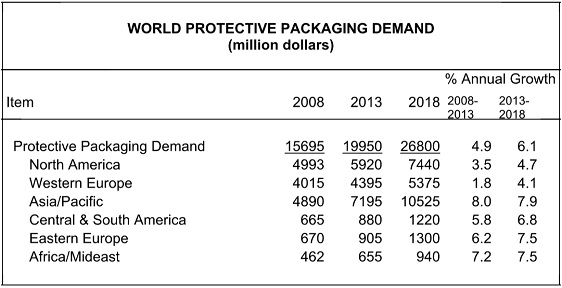Global demand for protective packaging to approach $27 billion in 2018
Retail segment expected to register the fastest growth, but manufacturing applications will continue to account for a sizable majority of protective packaging demand.
Latest Logistics News
Under-21 driver pilot program a bust with fleets as FMCSA seeks changes Diesel back over $4 a gallon; Mideast tensions, other worries cited Four U.S. railroads file challenges against FRA’s two-person crew mandate, says report XPO opens up three new services acquired through auction of Yellow’s properties and assets FTR’s Trucking Conditions Index weakens, due to fuel price gains More NewsWorld demand for protective packaging is projected to increase 6.1 % annually to nearly $27 billion in 2018.
According to a study from The Freedonia Group, a Cleveland-based market research firm, this growth will represent a significant improvement over the performance during the 2008-2013 period, when demand lagged in many of the largest protective packaging markets, including the US, Japan, and Western Europe. Going forward, accelerating manufacturing activity in these regions, coupled with continued strong growth in Internet retailing, will boost demand for nearly all types of protective packaging.
The Asia/Pacific region is expected to register the fastest growth in demand through 2018 due to the combination of its sizable manufacturing sector and the presence of several large, but still developing, economies. According to analyst Mike Richardson, “China will remain the largest market in the region and post rapid advances even as its economic growth begins to decelerate from the remarkable pace of the past few decades.”
The Africa/Mideast region and Eastern Europe will also experience above average growth, though both will remain fairly small regional markets. Advances will be below the global average in North America and Western Europe.
Good opportunities will still be found in many developed countries, especially for environmentally friendly protective packaging such as biodegradable products, which tend to be more expensive. The popularity of Internet-based shopping continues to grow at a much faster rate than for retail activity as a whole, and is generally more established in developed markets.
According to Freedonia, the e-commerce has created immense opportunities for manufacturers of protective packaging materials. Online retail still accounts for a small minority of overall retail sales, but its share will continue to grow rapidly as retailers expand their e-commerce presence, Internet accessibility continues to increase, and ownership of smartphones and other mobile devices grows. Although the retail segment is expected to register the fastest growth, manufacturing applications will continue to account for a sizable majority of protective packaging demand. In countries without a modern, developed retail sector, that majority can be more than 80% of overall demand.

Source: The Freedonia Group, Inc.

Article Topics
Latest in Logistics
Under-21 driver pilot program a bust with fleets as FMCSA seeks changes Diesel back over $4 a gallon; Mideast tensions, other worries cited Four U.S. railroads file challenges against FRA’s two-person crew mandate, says report XPO opens up three new services acquired through auction of Yellow’s properties and assets FTR’s Trucking Conditions Index weakens, due to fuel price gains U.S. rail carload and intermodal volumes are mixed, for week ending April 6, reports AAR LM Podcast Series: Examining the freight railroad and intermodal markets with Tony Hatch More LogisticsSubscribe to Logistics Management Magazine

Find out what the world's most innovative companies are doing to improve productivity in their plants and distribution centers.
Start your FREE subscription today.
April 2023 Logistics Management

Latest Resources














